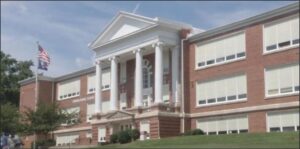by James A. Bacon
It has long been recognized that some of Virginia’s public schools are in scandalously poor condition — leaky roofs, mold, asbestos, outdated HVAC systems, clogged toilets, and so on. More than half of all school buildings in the state are greater than 50 years old. In mid-2021, school districts across Virginia had identified $9.8 billion of projects in their Capital Improvement Plans. Replacing all buildings 50 years or older would cost $24.8 billion, according to a Virginia Department of Education needs assessment.
As Radio IQ points out in an article today, Virginia engaged in a wave of public school construction in the 1950s and 1960s, and those buildings are aging out. No one knows where such funds will come from. Some counties are affluent enough that they can raise property taxes to cover the cost of issuing and paying off bonds. Some counties aren’t. The General Assembly is debating how to help, whether by providing half a billion dollars in grants or up to $2 billion in loans, reports Radio IQ.
Here’s what makes any discussion of state bail-outs tricky: some localities have been proactive, either raising taxes or setting aside reserves, while others have kicked the fiscal can down the road. There is a danger that a massive, statewide infusion of state funds into local school districts will subsidize the improvident and leave the prudent short-changed.
I live in Henrico County where voters decided several years ago to slap a new tax on restaurant meals to fund school retrofit projects and new construction. I objected strenuously at the time — I argued that there were opportunities for spending cuts and that property tax revenues would rebound (which they have) — but I credit the county at least with making it a priority to keep their schools in good condition rather than let them deteriorate with age.
Next door to Henrico is Goochland County, a rural/bedroom locality. The county was facing default on its bonds when a new slate of supervisors swept to power in 2011. The reformers implemented a regime of fiscal discipline: developing a 25-year Capital Improvement Plan for schools and other public facilities, determining when old bonds would be paid off and new bonds could be prudently issued, and setting aside reserves as needed to offset depreciation of its physical assets.
Not every locality planned ahead. Much of the original wave of school funding in the ’50s and ’60s came from the federal government. Woohoo! Free money! Many localities took the money, built the schools… and gave no thought to the fact that they might need to replace or retrofit them a half century later. Well, here it is 50 or 60 years later.
Complicating the picture, especially in Southside and Southwest Virginia, is the fact that the economies of many rural/small town localities have been hobbled by the destruction of mainstay industries such as coal, furniture, textiles, apparel, and tobacco. Compounding the challenge, populations have declined as the economies hollowed out, leaving fewer taxpayers to pay to replace the school buildings.
I acknowledge that maintaining fiscal discipline is difficult when you’re desperately poor and you have little commercial, industrial or retail business to support your tax base.
On the other hand, we have the example of the City of Richmond, which has some of the most deplorably maintained schools in the state — despite having a strong and growing tax base. The Richmond school district spends more per student than the surrounding counties, where schools are in better condition. What’s Richmond’s excuse for failing to fund proper maintenance and plan for an orderly replacement of old buildings?
Virginia lawmakers, who are enjoying a once-in-a-generation revenue boom, have a hard choice to make this session. Do they funnel state funds into school districts on a basis of “need,” thus subsidizing careless fiscal behavior in some cases? Or do they dole out the dollars equally, even if it means dispensing funds to localities that, thanks to their foresight, may not really need it?
Someone is bound to end up feeling like they drew the short straw. But, then, if the state flood of state funding is perceived as “free money,” maybe no one will care.



